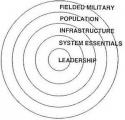Many planners and commanders have reached the conclusion that our planning processes need to be modified in order to incorporate lines of operations. While not a new concept, articles written by individuals such as LTG Chiarelli about their use of Lines of Operation in Iraq have renewed the debate. LTG Chiarelli used the following Lines of Operation: Combat Operations, Train & Employ Security Forces, Essential Services, Promote Governace, and Economic Pluralism. Others have suggested Rule of Law and Information Operations as appropriate LOOs. While working to assist the Sri Lankan Gov't against insurgents in the 1980s, Dr. Tom Marks developed a campaign based on the following LOOs: Elimination of Grievances, Population and Resource Control, and Military/Operational Measures. I would like to hear what others think of the utility of using the LOOs approach, as well as what they believe to be the most useful/appropriate LOOs for SASO/SROs. In addition, any discussion of what implied tasks fall under each line would be helpful.








 )...
)...

Bookmarks